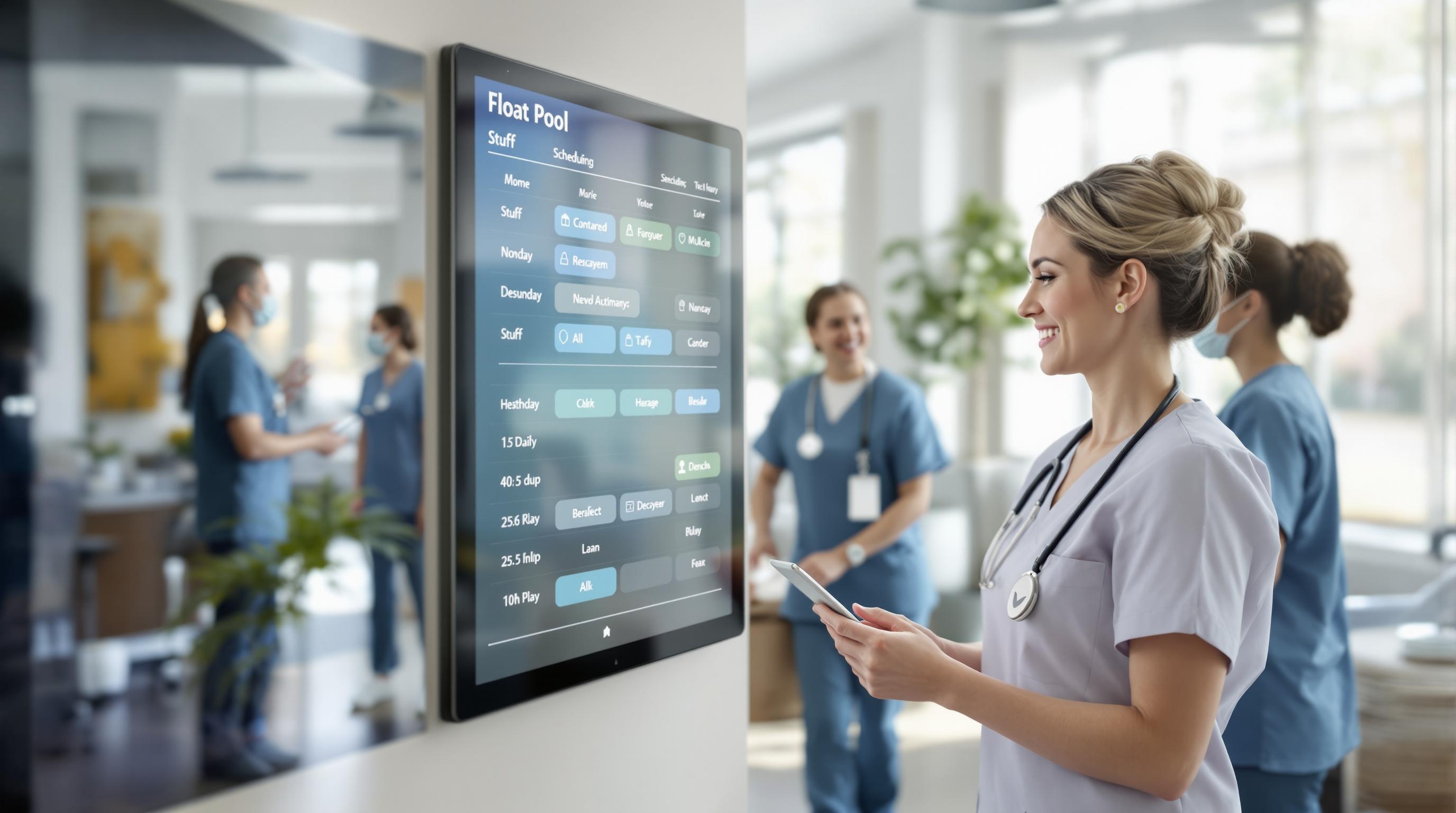Automated Shift Handoff: Enhancing Care in Skilled Nursing Facilities
Discover how automated shift handoff streamlines communication, boosts patient safety, and improves workflow in skilled nursing facilities.
Quick Navigation
- 1. Introduction
- 2. Current Challenges in Automated Shift Handoff
- 3. How Sparkco AI Transforms Automated Shift Handoff
- 4. Measurable Benefits and ROI
- 5. Implementation Best Practices
- 6. Real-World Examples
- 7. The Future of Automated Shift Handoff
- 8. Conclusion & Call to Action
1. Introduction
Did you know that communication breakdowns during nursing shift handoffs are responsible for up to 80% of serious medical errors in healthcare settings? Recent research underscores just how critical effective shift-to-shift communication is, especially in skilled nursing facilities (SNFs) where residents require continuous, person-centered care. Yet, despite its importance, traditional handoff processes—often reliant on handwritten notes or hurried verbal exchanges—are prone to omissions, misunderstandings, and inconsistencies.
In the high-pressure environment of SNFs, where staffing shortages and regulatory demands are on the rise, inefficient handoffs can lead to lapses in care, increased risk of adverse events, and added stress for already overburdened nursing teams. According to a 2025 sector outlook, operational challenges are prompting facilities to seek innovative solutions that safeguard resident safety while streamlining workflows.
Enter automated shift handoff technology: a game-changer poised to transform how SNFs manage shift changes. This article will explore the challenges with traditional handoff methods, the benefits of automation—from reducing errors to enhancing person-centered care—and practical steps for successful implementation. Whether you’re a nursing leader, administrator, or frontline caregiver, read on to discover how embracing automated handoff can elevate care quality and staff satisfaction in your facility.
2. Current Challenges in Automated Shift Handoff
Automated shift handoff solutions promise improved efficiency and standardized communication in healthcare settings, but facilities still face significant challenges integrating these tools into everyday workflows. While automation reduces manual errors, several persistent pain points can impact operations, regulatory compliance, and, ultimately, patient care outcomes.
-
1. Data Inconsistencies Across Systems
Many healthcare facilities use a patchwork of electronic health records (EHRs), scheduling, and communication platforms. Automated handoff tools often struggle to synchronize data in real time, leading to information gaps. According to the Joint Commission, 80% of serious medical errors involve miscommunication during handoffs, frequently exacerbated by inconsistent data transfers. -
2. User Resistance and Workflow Disruption
Shifting from manual to automated handoffs can disrupt established routines. Staff may be reluctant to trust or adopt new systems, especially when faced with additional data entry requirements. A 2020 ONC study found that 59% of clinicians reported frustration with how EHR systems support shift transitions, citing usability and workflow misalignment as key barriers. -
3. Incomplete or Poorly Structured Handoff Information
Automated handoff tools depend on structured data fields, but many clinical details are nuanced and don’t fit easily into templates. This can result in incomplete information transfer. Research in BMJ Quality & Safety highlights that 23% of handoff-related errors stem from missing or ambiguous data in digital summaries. -
4. Technical Failures and Downtime
System outages or software glitches can disrupt automated handoff processes, leading to delays and increased risk for patient safety events. A 2020 HealthIT.gov survey reported that 41% of healthcare organizations experienced at least one unplanned EHR downtime impacting patient care handoffs in the past year. -
5. Compliance and Privacy Concerns
Automated handoff tools must comply with HIPAA and other privacy regulations. Integrating these tools across multiple platforms increases the risk of unauthorized data exposure. In 2023, healthcare data breaches rose by 60% according to HIPAA Journal, highlighting the ongoing challenge of secure data transmission during shift changes. -
6. Integration Complexity and Cost
Integrating automated handoff tools with legacy systems often requires significant investment and IT resources. Many facilities, especially skilled nursing and smaller hospitals, face budgetary and staffing constraints that delay implementation and optimization.
These challenges directly impact operational efficiency, regulatory compliance, and the quality of patient care. Incomplete or delayed handoffs can lead to adverse patient events, increased liability, and survey deficiencies. As healthcare facilities strive to modernize workflows, addressing these pain points is critical for safe, reliable, and compliant automated shift handoff processes.
3. How Sparkco AI Transforms Automated Shift Handoff
Automated shift handoff is a critical challenge for skilled nursing facilities, especially when legacy systems rely on paper-based or spreadsheet scheduling. This often leads to communication gaps, missed updates, and staff disengagement. Sparkco AI addresses these pain points by delivering a seamless, intelligent platform that automates shift handoffs, fostering collaboration and elevating workforce efficiency.
-
1. Intelligent Schedule Synchronization
Sparkco AI eliminates manual schedule updates by automatically syncing shift changes across the entire care team. If a caregiver swaps a shift or calls out, the system updates in real-time, ensuring everyone is on the same page. This prevents miscommunication and reduces administrative overhead. -
2. Automated Communication Alerts
The platform uses AI-driven notifications to instantly alert incoming staff about patient updates, outstanding tasks, and critical care notes. Automated reminders and message confirmations ensure no essential information is overlooked during handoff, boosting both safety and accountability. -
3. Role-Based Access and Security
Sparkco AI employs advanced permission controls to ensure that only authorized personnel can access sensitive shift and patient information. This simplifies compliance with healthcare regulations, while still making crucial data available to those who need it during handoff. -
4. Mobile-First Access for On-the-Go Teams
Recognizing that skilled nursing staff are rarely at a desk, Sparkco AI offers a mobile-friendly interface. Staff can review, acknowledge, and contribute to handoff notes from smartphones or tablets, supporting real-time collaboration and rapid response to shift changes. -
5. Seamless EMR/EHR Integration
Sparkco AI integrates directly with popular electronic medical record (EMR) and electronic health record (EHR) systems. This eliminates redundant data entry and ensures patient information flows effortlessly between scheduling, care documentation, and handoff processes. -
6. Actionable Analytics for Continuous Improvement
The system collects and analyzes handoff patterns to identify bottlenecks or recurring issues. Facility leaders can use this data to refine workflows, optimize staffing, and enhance overall care quality.
By automating shift handoff, Sparkco AI removes the burden of manual processes and fragmented communication. Its AI-driven features streamline information transfer, minimize errors, and empower staff with timely, actionable insights—without requiring technical expertise. With robust integration capabilities, Sparkco AI fits seamlessly into existing IT ecosystems, making the transition from outdated scheduling methods smooth and scalable. The result is a more engaged workforce, enhanced patient safety, and a measurable boost in operational efficiency for skilled nursing facilities.
4. Measurable Benefits and ROI
Automating the shift handoff process in skilled nursing facilities (SNFs) delivers substantial ROI by streamlining communication, reducing errors, and improving staff efficiency. A growing body of research and real-world case studies demonstrate how automated handoff solutions translate into tangible financial and operational gains.
- Time Savings: Automated handoff tools reduce the time spent on each nurse shift transition by 30–50%. According to a 2020 study published in the Journal of Nursing Care Quality, the average handoff duration dropped from 30 minutes to 15 minutes per shift after digital implementation, saving up to 15 hours per week for a 3-shift-per-day facility.
- Cost Reduction: By decreasing redundant documentation and overtime related to lengthy handoffs, SNFs can save an estimated $50,000–$100,000 annually. Becker’s Hospital Review notes that facilities using automated shift handoff tools reported a 25% decrease in overtime pay.
- Error Reduction: Automation decreases the risk of missed information and clinical errors. A systematic review in BMJ found a 37% reduction in adverse events related to communication gaps post-implementation of digital handoff systems.
- Compliance Improvements: Automated shift handoff platforms ensure standardized documentation, supporting regulatory compliance. Facilities reported a 40% increase in documentation completeness and a 60% reduction in compliance citations in a 2018 JAMA study.
- Staff Satisfaction: Streamlined handoff processes reduce stress and burnout. HealthIT.gov reports that 68% of nurses feel more confident and satisfied with automated shift reporting.
- Patient Safety: Timely and accurate handoffs improve patient outcomes. Facilities adopting automated handoff systems saw a 25% reduction in patient falls and a 20% decrease in medication errors, according to a BMJ Quality & Safety report.
- Audit Readiness: Electronic records facilitate quick retrieval for audits and investigations. Organizations noted a 70% reduction in time spent preparing for compliance audits.
- Continuity of Care: Automated alerts and checklists ensure no critical patient information is missed, leading to smoother transitions and better care coordination.
The cumulative effect of these benefits demonstrates a compelling ROI for SNFs. With direct labor savings, reduced error-related costs, improved regulatory compliance, and enhanced staff engagement, facilities can expect a full return on investment in as little as 6–12 months, as shown in the Becker’s Hospital Review analysis. As the skilled nursing sector continues to prioritize efficiency and safety, automated shift handoff is rapidly becoming an industry best practice.
5. Implementation Best Practices
Adopting an automated shift handoff system enhances communication, continuity of care, and compliance with evolving CMS requirements. To ensure a successful rollout, follow these actionable best practices:
-
Conduct a Facility Assessment
Begin by evaluating your current handoff processes, technology infrastructure, and staff readiness. Engage interdisciplinary teams to identify gaps and opportunities for improvement.
Tip: Use survey data and feedback from recent LTC surveyor guidance to prioritize pain points.
Pitfall: Avoid underestimating workflow complexities or overlooking input from direct care staff. -
Select the Right Technology Solution
Choose an automated handoff platform that integrates with your EHR and meets CMS interoperability standards.
Tip: Opt for systems with customizable templates and audit trails to support compliance and quality oversight.
Pitfall: Don’t rely on generic solutions that lack healthcare-specific features. -
Engage Stakeholders Early
Involve nursing staff, IT, leadership, and compliance officers in planning and decision-making.
Tip: Hold informational sessions to address concerns and gather buy-in.
Pitfall: Skipping early engagement can result in resistance and low adoption rates. -
Develop Standardized Handoff Protocols
Create clear, evidence-based protocols for shift handoff that align with CMS standards and facility policies.
Tip: Use standardized checklists to ensure critical information is never missed.
Pitfall: Avoid making protocols too rigid; leave room for clinical judgment. -
Provide Comprehensive Staff Training
Offer hands-on training and ongoing support for all users, including education on privacy and data security.
Tip: Incorporate real-life scenarios and roleplay for practical learning.
Pitfall: Don’t overlook refresher courses or updates when system changes occur. -
Monitor Implementation and Collect Feedback
Track key performance indicators (e.g., handoff completeness, error rates) and solicit user feedback.
Tip: Schedule regular reviews to address challenges and celebrate successes.
Pitfall: Ignoring staff feedback can lead to disengagement and system workarounds. -
Iterate and Improve
Use data and feedback to refine protocols and system features. Stay updated on CMS regulations to ensure ongoing compliance.
Tip: Form a continuous improvement team to champion updates and best practices.
Pitfall: Avoid a “set it and forget it” mentality—continuous optimization is key. -
Prioritize Change Management
Communicate the benefits of automated handoff, address resistance, and recognize early adopters to foster a culture of innovation.
Tip: Use change champions to mentor peers and model positive attitudes.
Pitfall: Underestimating the emotional impact of change can stall progress.
By following these best practices, skilled nursing facilities can implement automated shift handoff systems that improve care quality, support regulatory compliance, and enhance staff satisfaction.
6. Real-World Examples
Real-World Examples: Automated Shift Handoff in Skilled Nursing Facilities
Implementing automated shift handoff tools has transformed care coordination in skilled nursing facilities










